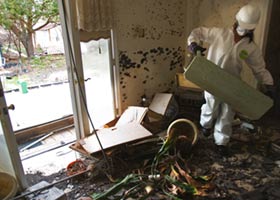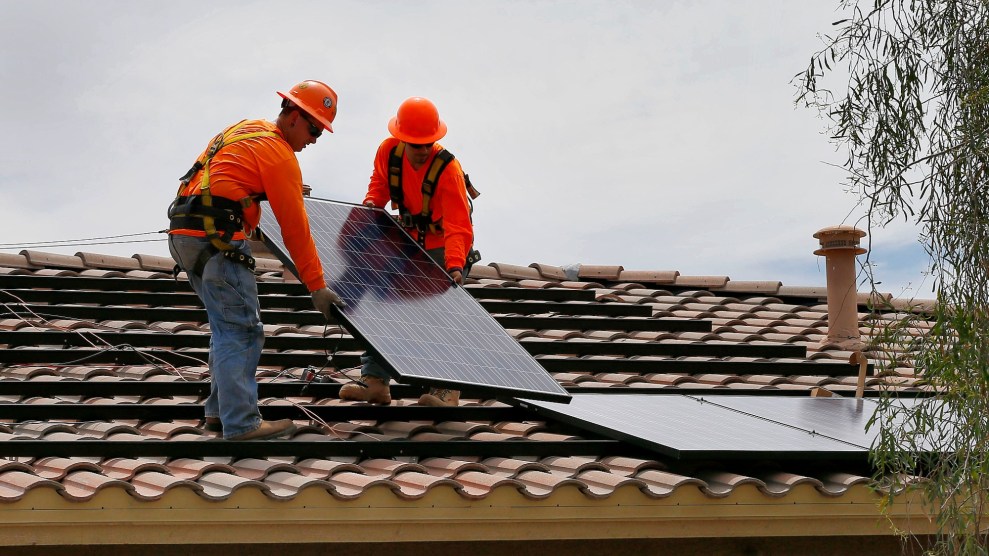
Photo: Sarah Cross
Yesterday, in the second installment of his three-part series, “Storm Warning,” John McQuaid visited the Netherlands, whose state-of-the-art system for protecting its coast could offer the United States lessons for buffering our own vulnerable coastal communities—that is, if the government is willing to make this a national priority. So far the president has committed to building a “flood protection system stronger than it has ever been,” which, frankly, isn’t saying very much. Today, in the conclusion of the series, McQuaid reports on what it will take to strengthen the nation’s coastal defenses: among other things, efforts to preserve and rebuild the vanishing marshlands that act as a natural barrier to storm surges; a shake-up at the feckless U.S. Army Corps of Engineers, an agency that has carried out wasteful pork-barrel projects while ignoring those intended to keep Americans safe; and, yes, a national commitment to protecting coastal communities. The need to take bold action should have been evident after Katrina destroyed one of America’s most storied cities. Sadly, it may take another Katrina before the government gets the message.
-The Editors
The term “terraforming”—reshaping the surface of another planet for human settlement—was coined by science-fiction writers. And that’s not too far from what engineers must do for the Mississippi delta. They must resculpt a patchwork of degraded marshland, ruined city neighborhoods, and sprawling subdivisions into an integrated defense against flooding.
Part of the idea is to revive the process that built the Mississippi delta in the first place. When New Orleans was founded, rising, silt-laden water overflowed the riverbanks each spring, refreshing and expanding the marshes. The river levees constricted this flow in the 19th century, and the entire delta started slowly sinking back into the sea. Now scientists want to try strategically breaching the levees, diverting river water over the marshes to deposit silt once again. Those projects would be knit together with upgraded levees, walls, and floodgates at a cost of $50 to $55 billion spread over several decades, according to Louisiana officials.
On an array of high-resolution monitors in Joannes Westerink’s Notre Dame University lab in South Bend, Indiana, a virtual storm is taking shape and crashing into a digital New Orleans. Anyone watching the news coverage of Katrina was treated to images like these—computer programs capable of digitally recreating landscapes and weather patterns, rerunning historical storms, even rearranging the configuration of levees and wetlands to test different designs and possible outcomes. It was these simulations that back in the 1980s and 1990s revealed shocking weaknesses in the levee system—yet Corps “muddy boots” traditionalists scorned modeling and never bothered to use it to reassess their decades-old designs.
A native of the Netherlands, with a mathematician’s clinical detachment, Westerink has worked for years to bring the virtual world into ever-more precise alignment with the real world of wind, water, and barriers made of mud. Katrina provided both a wealth of new data and, in the end, funding from a reawakened Corps. Now that the Corps is finally interested, the models are revealing huge and dangerous defects in the entire delta layout.
Westerink, who has rerun his virtual Katrina hundreds of times, fires up his monitor once more for me. Speaking in a soft monotone, he explains that the river levees, which bisect the delta marshes for a hundred miles southeast of New Orleans, are the highest objects around. As Katrina approached from the south that August 29, it began pushing water against the river levees. Water built up against the walls and then moved northward with the storm, swallowing small towns. Some of that buildup flowed into metro New Orleans. Then, as Katrina passed east of the city, it propelled the rest of the huge wave straight into the Mississippi coast, where it reached a height of 30 feet, the highest storm surge ever to hit the U.S. coast. If the river levee hadn’t been there—or had been designed differently—the devastation would have been far less.
“Can you control that flow?” Westerink asks. “This becomes a huge federal problem of who gets whose water.” The hurricane risk to the Mississippi and Alabama coasts would be much lower if the river levees disappeared tomorrow. But nobody, least of all the Corps, wants to tell that to the shipping companies. Westerink and some Corps scientists say one solution is to cut big gaps in the levees, so storm surge waves would flow through and dissipate. That might preserve navigation, but it also would upend life in the delta as it’s existed for more than a century. Louisiana towns such as Venice, at the extreme southeast end of the river, would literally become islands, tethered to each other by bridges. Places left outside the hurricane protections, such as Isle de Jean Charles, a tiny community of Indians from the Biloxi-Choctaw-Chitimacha tribe southwest of New Orleans, would probably disappear.
Clearly, such big fixes will make government agencies and political jurisdictions think about things they never imagined before. But thinking big is necessary; the alternative is to face more Katrina-sized storm surges—which will be increasingly likely given warming seas and melting polar ice—with weak flood defenses.
The most ambitious piece of any coastal protection plan will be rebuilding Louisiana’s raggedy, sinking marshes. Anyone who grew up on the bayou knows that marshes help reduce storm surges. But official flood control policy has always focused on levees, so very few scientists—and no one in the Corps—had ever looked at just how that happens. That changed in 2002, when Tropical Storm Isidore nearly flooded Corps geologist John Lopez’s house on Lake Pontchartrain. Isidore was a weak storm, yet its surge was large; Lopez wondered if the area’s vanishing marshes had had anything to do with it.
Louisiana’s vast wetlands have been sinking and eroding for decades. Since the 1930s, approximately 1,900 square miles of land has vanished—a swath roughly the size of the state of Delaware. In a single year, Hurricanes Katrina and Rita washed away an additional 217 square miles, according to a recent study by the U.S. Geological Service. Since then, scientists have grown even more alarmed at the rate at which erosion has been outpacing the modest efforts at coastal restoration. Rebuilding wetlands isn’t easy, and it’s that much harder if they’re disappearing. In many places it will be possible only to slow the pace of erosion, not reverse it. Unless major progress is made in the next decade, the Times-Picayune reported in March, some coastal scientists say the delta may enter a kind of death spiral.
Taking these trends into account, and working on his own time, Lopez began examining every feature of the delta landscape that could possibly offer protection from a surge wave, starting with the continental shelf and ending with evacuation routes. Stands of cypress trees, expanses of marsh grass, elevated roadways, and clusters of fishing camps all slow down a storm surge. By the spring of 2005, he had put together something called “multiple lines of defense,” a radical yet intuitively simple new approach built on the notion that all the elements involved in flood control must work together—or they won’t work at all. In June 2005, Lopez presented his “lines of defense” outline to the chief engineer of the Corps’ New Orleans district. Nice idea, he was told. But no way the agency would implement it. “You know, the Corps tends to see itself rigidly,” Lopez recalls his boss saying. “This is a good idea. But we just don’t think we could do it.” Katrina hit two months later.
I met Lopez at the Bonnet Carré Spillway just upriver from New Orleans. A short, compact man with flecks of gray in his hair and a heavy beard, he speaks a bit haltingly, as if he’s still working things out in his head. We drove along the levee in his silver Toyota pickup, covering ground very much like the original site of New Orleans, before development covered all available space—a marsh between river and lake, part dense cypress forest, bayou waters glinting through the trees. To our right, suburban homes sat atop a low, sloping ridgeline—with both a levee and a stretch of marshland between them and Lake Pontchartrain. The lake poses the greatest threat to New Orleans, which sits on its south rim. It’s not really a lake but a big salt water lagoon, connected to the Gulf of Mexico via two deep channels. During a storm it can fill like a bathtub. If the water rises high enough to top or breach the levees, it will flood most of the metro area.
We stopped and hopped out onto the gravel track, gazed toward the lake, and imagined a storm surge coming our way. “When you have a wetland in front of a levee, two things will happen,” Lopez explained. “Wetlands can reduce the actual elevation of the surge—trees, especially, will reduce waves and wind-driven water heights. This should be our model for development. Build on ridges, which are high to begin with. Then you’ll have a back levee with wetlands on the other side. In New Orleans and Jefferson Parish, they didn’t do that. They just built out to the lakefront.”
During Katrina, that pattern proved disastrous. Rather than being slowed and diverted by various natural features, floodwaters simply rose adjacent to neighborhoods until the levees collapsed. And yet the flooding is only a fraction of what could happen if the remaining coastal wetlands disappear: Right now, the New Orleans area is fringed with marshes that extend for dozens of miles, literally into the Gulf of Mexico. Without them, the ocean will lap at the hurricane levees. New Orleans will become Venice, except that Venice has no hurricanes.
After Katrina, Lopez’s plan was dusted off; it is now the basis of the state’s coastal protection plan, and the Corps has adopted a similar notion that it dubs “Louisiana Coastal Protection and Restoration,” or LACPR. But it will take a lot more than a new acronym to do the job.
Corps officials seem genuinely chastened by their New Orleans failures. But at the moment that it desperately needs to be innovating, the agency remains insular and plodding, driven mostly by large, wasteful projects to facilitate shipping—not hurricane protection. Neither the White House nor Congress has even tried to shake up the Corps’ management in the way NASA was following its two shuttle disasters. The Corps’ own post-Katrina investigation was purely an engineering endeavor; it delved only into the failure mechanisms in soil, concrete, and steel, ignoring the institutional problems.
And when the Corps does show a glimmer of initiative, the Bush administration seems determined to stifle it. Last summer, officials at the White House Office of Management and Budget and the Army squelched an early draft of the Corps’ long-term flood control study; no one, including Louisiana’s congressional delegation, ever got a straight answer on why. The draft contained some possible designs and solutions; the scrubbed version offered only something called “decision matrices” for figuring stuff out later. Lately, the Corps has even backed off its congressional mandate to design options for Category 5 protection. Officials now say that they’re instead examining ways to repel a surge from a Katrina-like storm. That would make the city safer than it is now, but would also repeat the major strategic error of the past. Levees and other flood defenses have always been built to prevent the last disaster, not the next one. Then a bigger storm comes along.
The uncertainty about the future of hurricane protection is a perceptible drag on the entire recovery effort. And in a place where government has failed so spectacularly, on so many levels, many people no longer believe the Corps or other decision makers are acting in their best interests. That distrust has sparked the creation of several vocal citizens’ groups that lobby on hurricane issues—among them the east New Orleans Vietnamese community that challenged the placement of the Old Gentilly Landfill. Its several thousand members had not been very politically active before Katrina. After the storm, disaster recovery agencies paid them little attention. In late 2005, a commission issued a controversial map, later abandoned, suggesting a moratorium on building permits in much of the city, including eastern New Orleans. “The funny thing was,” said Reverend Vien Thé Nguyen, the pastor of the local Mary Queen of Vietnam Catholic Church, “as we have insulated ourselves so much, we weren’t even on that map. Neither were we on the Urban Land Institute map [another early planning document], nor were we on the most recent FEMA flood map. I mean literally: We were not on the map. So now we want to make sure we are on the map. So that when they do any consideration, they better count us in.”
Most New Orleanians paid little attention to the details of hurricane protection before Katrina, so this new activism can make a difference. But a process that involves congressional appropriations, the White House, the Army, the state, and a mountain of arcane engineering studies has a lot of built-in insulation against grassroots involvement.
The basic unseriousness of the federal response to Katrina has been apparent since the president addressed the nation from Jackson Square on September 15, 2005. He didn’t say “never again.” His carefully-worded promise was for a “flood protection system stronger than it has ever been.” The bar wasn’t high, and the minimalist goal has indeed been achieved.
Last winter, President Bush did sign a law granting Louisiana and other Gulf Coast states a big chunk of royalty payments from new offshore oil and gas development—money that should provide Louisiana coastal projects an estimated $13 billion over the next 30 years. But most of that money doesn’t begin flowing for another decade, and the marshes could be too far gone by then.
What’s needed beyond these opening bids is a genuine national commitment—not just to New Orleans, but to protecting the entire U.S. coastline. No one knows precisely how high sea levels will rise, but every inch makes a difference in how severe, and frequent, floods become. Structures that might do the job today won’t be up to the task in the coming decades. Low-lying cities near the coast, such as Houston and Charleston, are particularly vulnerable, as are places with already-weak levees such as Sacramento and San Francisco. If rainfalls increase, inland river communities will also face new problems.
The Corps’ old levee system was built on the assumption that all circumstances it had to confront—the land, the sea, the frequency and size of hurricanes—were more or less static. When you have all the variables accounted for, building a wall will do the trick. Today, none of the variables is stable, and they’ll be less so with each passing year.
New Orleans might have been a national lab for innovative solutions. But the approach of the Bush administration has been to throw money at the problem—or rather, at contractors. The centerpiece of the rebuilding effort, for example, is called the “Road Home,” and is intended to reimburse people for their damaged homes so they can either rebuild or cash out their property. But the $7.5 billion in federal funds flowed through the state bureaucracy and then to an incompetent contractor, Virginia-based ICF International. The result was an estimated $5 billion shortfall and long delays in distributing the money. As applications continued to come in, overwhelmed officials announced they would stop taking them effective July 31, over the objections of community groups. By then, the program had closed out only 22 percent of its applications and distributed $2.7 billion.
As new environmental threats appear, it’s going to become more and more obvious that the nation’s political levees are just as poorly designed as those that failed New Orleans two years ago. Sadly, it may take more Katrinas to get the bureaucracy reengineered. “Just as we discovered the levees are made out of crap, we discovered the whole water resources and flood protection system is also built out of crap,” said Oliver Houck, a Tulane University law professor who has followed the issue for decades. “It’s like the Wizard of Oz—you pull back the curtain and there’s nobody back there.”








